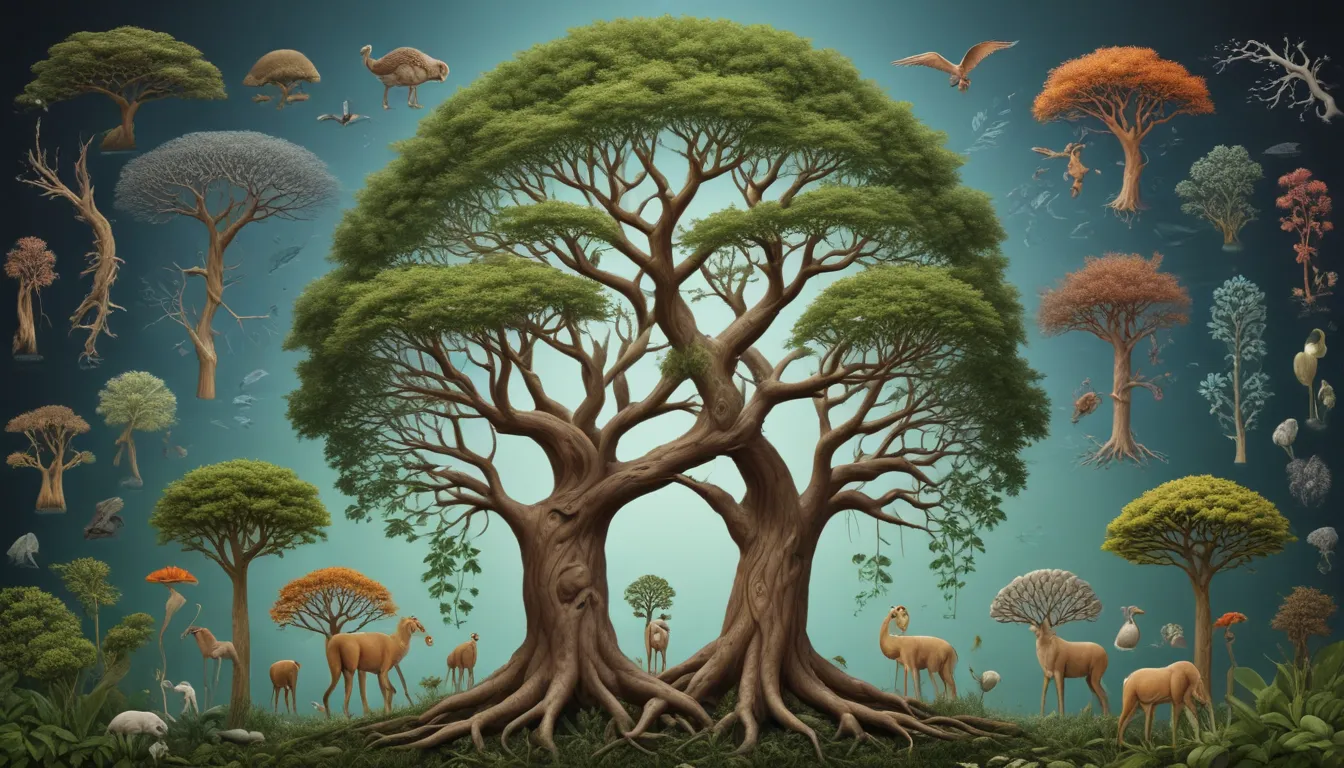A Note About Images: The images used in our articles are for illustration purposes only and may not exactly match the content. They are meant to engage readers, but the text should be relied upon for accurate information.
In the vast realm of biology, one concept that stands out as both captivating and essential is the phylogenetic tree. This branching diagram serves as a visual representation of the evolutionary relationships between different species, offering valuable insights into the history of life on Earth. Not only does the phylogenetic tree showcase how various organisms are connected, but it also helps scientists unravel critical information about their shared traits, genetic sequences, and common ancestors.
Understanding Phylogenetic Trees
Phylogenetic trees, often likened to a big family tree, demonstrate the interconnectedness of all living things. These diagrams play a vital role in enabling scientists to comprehend the relationships and histories of different organisms, ranging from microscopic bacteria to majestic whales. By studying phylogenetic trees, researchers can glean knowledge about the spread of diseases, protect endangered species, and unlock the mysteries of evolution. In essence, these tree structures unveil the beauty and unity of life on our planet.
Unraveling the Origins of Phylogenetic Trees
The concept of phylogenetic trees traces back to the mid-19th century, with Charles Darwin introducing the notion of common ancestry among species. Over time, through the study of comparative anatomy and genetics, scientists developed a method to represent evolutionary relationships using tree-like diagrams.
Deciphering the Phylogenetic Tree
At its core, a phylogenetic tree serves as a visual depiction of the evolutionary history and relationships between diverse organisms. It showcases the branching pattern of descent from a shared ancestor, with each branch signifying a unique lineage.
Delving into the Tree of Life
The renowned “Tree of Life” embodies a phylogenetic tree aiming to illustrate the evolutionary connections between all living organisms on Earth. This iconic representation showcases the exceptional diversity of life and offers profound insights into the origins and relationships among species.
The Intricacies of Branches and Nodes
Within a phylogenetic tree, branches symbolize evolutionary pathways, while nodes represent common ancestors. The length of branches often reflects the extent of evolutionary change that has occurred over time.
Unveiling Cladistics and Phylogenetic Analysis
Phylogenetic trees are constructed using a method called cladistics, which groups species based on shared characteristics. Phylogenetic analysis involves comparing and analyzing specific traits or genetic markers to discern evolutionary relationships.
Bridging Fossils and Phylogenetic Trees
Fossils play a pivotal role in constructing phylogenetic trees by providing evidence of extinct species and their relationships to existing organisms. These fossil records aid scientists in piecing together the puzzle of evolutionary history.
Harnessing Molecular Clocks
Molecular clocks serve as valuable tools in phylogenetic analysis, allowing scientists to estimate the timing of evolutionary events. By comparing DNA sequences or protein structures, researchers can determine the rate of genetic change and infer the divergence time between species.
Uniting Phylogenetics and Biogeography
Phylogenetic trees offer insights into the distribution of species across geographic regions. By mapping evolutionary relationships onto geographical maps, scientists can unveil patterns of speciation and migration.
Redefining Taxonomy with Phylogenetic Trees
Phylogenetic trees have revolutionized the field of taxonomy by providing a robust framework for classifying and naming organisms. The hierarchical structure of these trees enables a more systematic and accurate categorization of species.
Uncovering Phylogenetic Trees in Medicine
Phylogenetic analysis transcends the study of species evolution, playing a crucial role in comprehending the spread of diseases and formulating targeted treatment strategies.
Embracing the Limitations of Phylogenetic Trees
While potent tools, phylogenetic trees face limitations such as incomplete fossil records, horizontal gene transfer, and convergent evolution, which can complicate the accurate representation of evolutionary relationships.
Empowering Conservation Efforts with Phylogenetic Trees
Phylogenetic trees provide invaluable insights into biodiversity conservation by identifying evolutionarily distinct species or those at risk of extinction. This enables more effective targeting of conservation efforts.
Embracing the Tree-Thinking Concept
The concept of “tree-thinking” underscores the shift in perspective that phylogenetic trees bring to our understanding of evolution. It emphasizes the interconnectedness and shared history of all living organisms.
Illuminating Phylogenetics in Evolutionary Biology
Central to the field of evolutionary biology, phylogenetic trees enable scientists to study speciation patterns, identify key evolutionary events, and unravel the mysteries of life’s history.
Navigating Phylogenetic Inference Methods
Various methods exist for inferring phylogenetic trees, including Maximum Likelihood, Bayesian Inference, and Neighbor-Joining. Researchers select the most appropriate approach based on their data and research questions.
Harnessing the Power of DNA Sequencing
The advent of DNA sequencing technology has transformed phylogenetics, providing a wealth of information for constructing detailed and precise phylogenetic trees.
Unraveling the Complexity of Phylogenetic Trees
Phylogenetic trees can pose immense complexity, particularly in large-scale studies or diverse organism groups. Advanced computational tools and algorithms are pivotal in analyzing and interpreting these intricate evolutionary relationships.
Embracing the Beauty and Wonder of Phylogenetic Trees
Beyond a scientific lens, phylogenetic trees encapsulate the beauty and interconnectedness of our natural world. They serve as a poignant reminder of the incredible diversity and unity of life on Earth.
Embarking on a Journey of Discovery
As we delve deeper into the captivating world of biology, there is a wealth of knowledge waiting to be uncovered. From systematics to molecular biology and bioinformatics, each domain offers a unique perspective on the intricate tapestry of life on our planet.
In Conclusion
Phylogenetic trees stand as indispensable tools that illuminate the evolutionary relationships between diverse species. They not only provide a visual representation of how organisms are linked but also enable us to trace their ancestral roots. By studying phylogenetic trees, scientists unravel the complex web of life on Earth, gaining profound insights into evolutionary processes. This journey through branches, nodes, and patterns guides researchers in predicting common ancestors, identifying shared traits, and classifying organisms into distinct groups—a pivotal resource in evolutionary biology, systematics, and conservation.
FAQs:
Q: What is a phylogenetic tree?
A: A phylogenetic tree is a diagram that represents the evolutionary relationships between different species or groups of organisms.
Q: How are phylogenetic trees constructed?
A: Phylogenetic trees are constructed using various methods, including genetic data analysis, morphological comparisons, and fossil records.
Q: Why are phylogenetic trees important?
A: Phylogenetic trees are crucial for understanding evolutionary history, biodiversity, and the classification of organisms.
Q: Can phylogenetic trees change over time?
A: Yes, with advancements in technology and research, our understanding of evolutionary relationships can evolve and lead to updates in the tree’s structure.
Q: What is the significance of nodes in a phylogenetic tree?
A: Nodes represent common ancestors from which different species or groups diverged.
Q: How can I interpret a phylogenetic tree?
A: Look for branching patterns, lengths of branches, and the position of organisms or groups on the tree to understand relationships, time of divergence, and evolutionary distance.
Explore the fascinating realm of phylogenetic trees, where the mysteries of life’s evolutionary history unfold before your eyes. Through these interconnected branches, we gain a deeper appreciation for the diversity and unity of life on our planet. Let’s continue our journey of discovery, fueled by curiosity and a passion for unraveling the profound complexities of the natural world.






